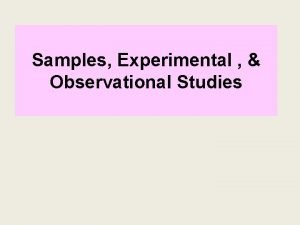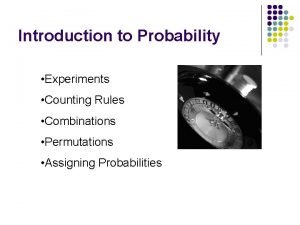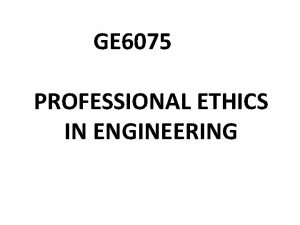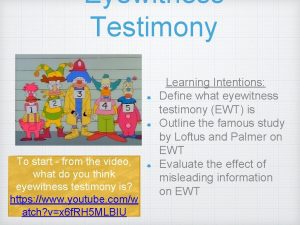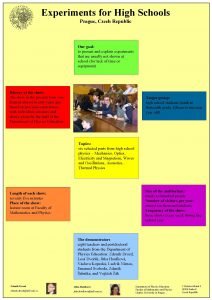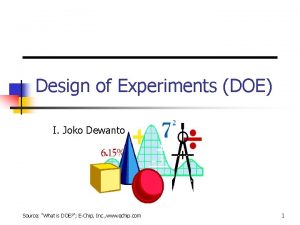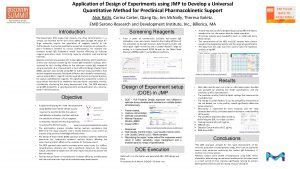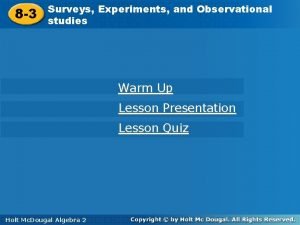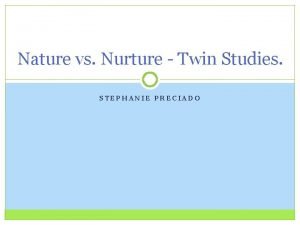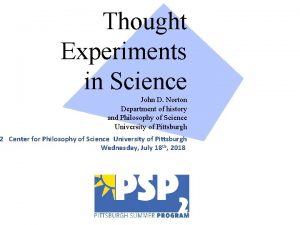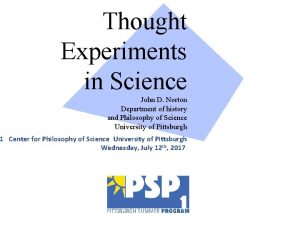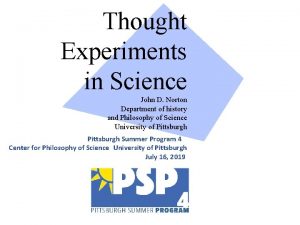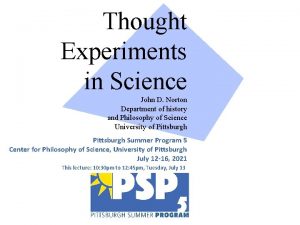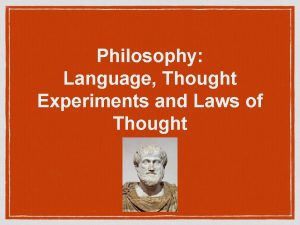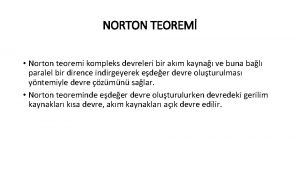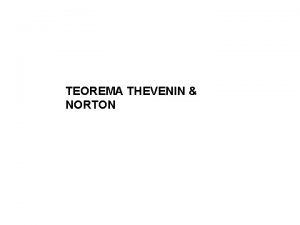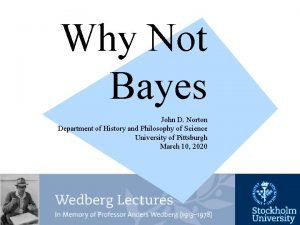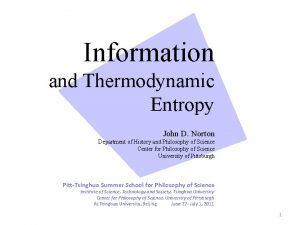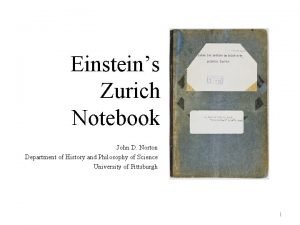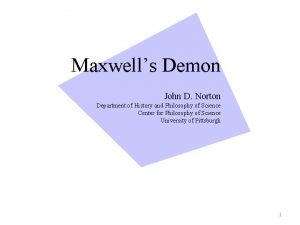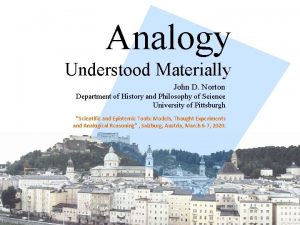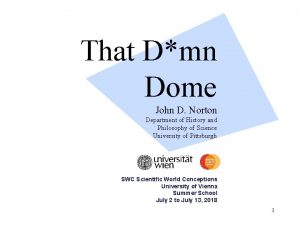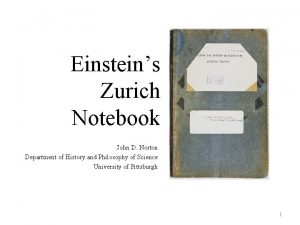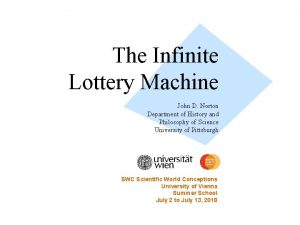Thought Experiments in Science John D Norton Department





































- Slides: 37

Thought Experiments in Science John D. Norton Department of history and Philosophy of Science University of Pittsburgh 1 Center for Philosophy of Science University of Pittsburgh Wednesday, July 12 th, 2017

http: //www. pitt. edu/~jdn orton/lectures/CPS_sum mer_2017/CPS_summer _2017. html 2

Please Think About this Problem The epistemological problem of thought experiments in science: How can merely experimenting in thought provide new knowledge of the natural world? Replacement for the superconducting supercollider. www. thought-experiment-jokes. com 3

Three Thought Experiments 1. Maxwell’s Demon 2. The Rotating Disk 3. The Dome 4

1. Maxwell’s Demon 5

Thermodynamics versus the molecular kinetic theory. Heat ALWAYS passes from hot to cold only. Unconfined gases ALWAYS expand. 6

Thermodynamics versus the molecular kinetic theory. A molecular gas can spontaneously recompress. The microscopic physics of molecular gases is not directed in time. 7

Theory of Heat, 1871, first ed. Also Letter to Tait, 1867; Rayleigh 1871 8

Theory of Heat Better scan from 1872, 2 nd ed. 9

Maxwell’s Proposal air initially at uniform temperature “He will thus, without expenditure of work, raise the temperature of B and lower that of A, in contradiction to the second law of thermodynamics. ” 10

Maxwell’s Moral: The Demon Wins “This is only one of the instances in which conclusions which we have drawn from our experience of bodies consisting of an immense number of molecules may be found not to be applicable to the more delicate observations and experiments which we may suppose made by one who can perceive and handle the individual molecules which we deal with only in large masses. In dealing with masses of matter, while we do not perceive the individual molecules, we are compelled to adopt what I have described as the statistical method of calculation, and to abandon the strict dynamical method, in which we follow every motion by the calculus. ” Theory of Heat. The demon illustrates that Second Law would fail if we could manipulate individual molecules. No compulsion to exorcise the demon to protect the Second Law. …. Nanotechnology has not yet overturned the Second Law. 11

2. The Rotating Disk 12

Einstein’s Discovery of Relativity Theory 1905 Special relativity Apply the principle of relativity to inertial motion. 1907, 1908, 1909, 1910, 1911, 1912, 1913, 1914, 1915. Extend the principle of relativity to accelerated motion. rotation ? ? ? Rectilinear acceleration Gravity slows clocks, slows and bends light. 13

Rotating Disk 1912 circumference = π x diameter measured by laying out rods end to end. circumference > π x diameter measured by laying out moving, contracted rods end to end. Length of radial rods unaffected by motion. Geometry found on a rotating disk is non-Euclidean. 14

3. The Dome An Indeterminstic Newtonian System 15

The Arrangement A unit mass sits at the apex of a dome over which it can slide frictionless. The dome is symmetrical about the origin r=0 of radial coordinates inscribed on its surface. Its shape is given by the (negative) height function h(r) = (2/3 g)r 3/2. The mass experiences an outward directed force field F = (d/dr) potential energy = (d/dr) gh = r 1/2. The motion of the mass is governed by Newton’s “F=ma”: d 2 r/dt 2 = r 1/2. 16

Possible motions: None r(t) = 0 solves Newton’s equation of motion since d 2 r/dt 2 = d 2(0)/dt 2 = 0 = r 1/2. 17

Possible motions: Spontaneous Acceleration The mass remains at rest until some arbitrary time T, whereupon it accelerates in some arbitrary direction. r(t) = 0, for t≤T and r(t) = (1/144)(t–T)4, for t≥T solves Newton’s equation of motion d 2 r/dt 2 = r 1/2. For t≤T, d 2 r/dt 2 = d 2(0)/dt 2 = 0 = r 1/2. For t≥T d 2 r/dt 2 = (d 2 /dt 2) (1/144)(t–T)4 = 4 x 3 x (1/144) (t–T)2 = (1/12) (t–T)2 = [(1/144)(t–T)4]1/2 = r 1/2 18

The computation again For t≤T, d 2 r/dt 2 = d 2(0)/dt 2 = 0 = r 1/2. For t≥T d 2 r/dt 2 = (d 2 /dt 2) (1/144)(t–T)4 = 4 x 3 x (1/144) (t–T)2 = (1/12) (t–T)2 = [(1/144)(t–T)4]1/2 = r 1/2 19

The Dome without Calculus Imagine the mass projected from the edge. Close… 20

The Dome without Calculus Imagine the mass projected from the edge. Closer… 21

The Dome without Calculus Imagine the mass projected from the edge. BINGO! Now consider the Spontaneous time reversal of motion! this process. BUT there is a loophole. Spontaneous motion fails for a hemispherical dome. How can the thought experiment fail in that case? 22

How do these thought experiments inform us? 23

Epistemologies of Thought Experiments Platonism, Intuitionism Brown Experimentalism Sorensen Constructivism Kuhn, Gendler Visualization and Simulation Arthur Mental Models Nersessian, Palmieri Arguments Norton Laws of nature reside in a Platonic world. We perceive the laws directly in the right sort of thought experiment. Thought experiments gain epistemic power through their mimicry of real experiments. Thought experiments reveal lacunae in our conceptual systems and show us how to reconfigure them. The mind has the power to simulate the world through visualization. Thought experiments are the manipulation of mental models discussed in recent cognitive science. Thought experiments are merely disguised, picturesque argumentation. 24

The Argument View 25

The Argument View: Principal Claims Thought experiments Since… are arguments that happen also to (i) posit hypotheticals or counterfactuals (“thought”); (ii) invoke irrelevant particulars (“experiment”). …no epistemic mysteries. Reliability thesis (more shortly). Context of Justification All thought experiments can be reconstructed as arguments based on tacit or explicit assumptions. Belief in the outcome is justified only in so far as the reconstructed argument is cogent. (“The reconstruction thesis”) Context of Discovery The actual carrying out of a thought experiment is the execution of an argument, even if in disguised form. (“The execution thesis”) …no counterexamples known to me (but many claimants). …the epistemic reach of a thought experiment coincides with the reach of an argument. 26

Einstein’s Rotating Disk Thought Experiment Reconstructed (D 1) In Euclidean geometry, the measured circumference of a disk is π times its diameter. (Premise) (D 2) The geometry of a non-rotating disk is Euclidean. (Premise) (D 3) The motion of a radial element on a rotating disk is perpendicular to its length, so that (according to special relativity) the length is unaltered. (Premise) (D 4) The motion of a circumferential element on a rotating disk is along its length, so that (according to special relativity) the length is contracted. (Premise) (D 5) Therefore the measured circumference of a rotating disk is more than π times the measured diameter. (From D 2, D 3, D 4) (D 6) Therefore the geometry of a rotating disk is not Euclidean. (From D 1, D 5) 27

The Case for the Argument View Accept the argument view since: No epistemic miracles. Thought experiments take what we already know tacitly and make it explicit by means that… …preserve truth; deductive argument …or preserve its probability. inductive argument Reject any other view since: Reliability Thesis If thought experiments can be used reliably, epistemically, then they must be arguments that justify their outcomes by an identifiable logic , construed very broadly, or reconstructible as them. 28

Thought Experiment – Anti Thought Experiment Pairs and the case for the reliability thesis. 29

Thought Experiment Anti-Thought Experiment Pairs (three) C<πD Moving rings contracted circumferentially but not radially Petzold (to Einstein, July 26, 1919) C>πD Tangential rods contracted Radial rods uncontracted Einstein 1912 C=πD Figures at an instant traced onto non-rotating tracing paper. Varicak 1911 (after a method by Ehrenfest) 30

The Helicopter: the Thought Experiment What is the lift generated by an infinite, nonrotating rotor? Double rotor size. Halve rotor speed. Rotor lift stays the same (at L). Power consumed is halved. In the limit of infinitely many doublings, an infinite, non-rotating rotor generates lift L and consumes no power. “That must be how angels work. Wide wing spans. ” --Jeremy Butterfield 31

The Helicopter: the Anti-Thought Experiment What is the lift generated by an infinite, nonrotating rotor? A finite, nonrotating rotor generates no lift. Double rotor size. Rotor still generates no lift. In the limit of infinitely many doublings, an infinite, non-rotating rotor generates no lift. 32

Three Step Argument for the Reliability Thesis 1. Thought experiment anti-thought experiment pairs Thought experiments can err. 2. Thought experiments can be used reliably. They are governed by a generalized logic 3. Evolution of the study of logic. The logics of thought experiments are the standard deductive and inductive logics. 33

For more on Steps 2. and 3. : 34

Conclusion: How do Other Epistemologies Recover Reliability? 35

How do other epistemologies explain the reliability of thought experimentation? Platonism By analogy to vision. The disanalogy with Platonic vision is that we have no independent way to check if we misperceive Platonically. Experimentalism By analogy to ordinary experiment? Does replicating a bad thought experiment reveal its failure? Constructivism Reconfiguration arrived at by "constructive participation. ” How do we know when we participate erroneously? Visualization and simulation How do we distinguish reliable visualizations from fantasies of the imagination? Mental Models Mental models do supply a generalized logic that can designate flawed manipulations as erroneous. 36

THE END 37
 Complete incomplete thought
Complete incomplete thought John d. norton
John d. norton John d norton
John d norton John d norton
John d norton Science experiments for highschool
Science experiments for highschool Computer science experiments
Computer science experiments Integrated science lab experiments
Integrated science lab experiments Risk assessment for science experiments
Risk assessment for science experiments Describe your favourite subject
Describe your favourite subject Ucl computer science faculty
Ucl computer science faculty Electrical engineering northwestern
Electrical engineering northwestern Computer science department rutgers
Computer science department rutgers Department of forensic science dc
Department of forensic science dc Oh.nesinc
Oh.nesinc Meredith hutchin stanford
Meredith hutchin stanford Fsu cybersecurity major
Fsu cybersecurity major Ubc computer science department
Ubc computer science department Department of computer science christ
Department of computer science christ Sangeeta santra iit delhi
Sangeeta santra iit delhi Webnis
Webnis![[http://earthobservatory.nasa.gov/experiments/biome/] [http://earthobservatory.nasa.gov/experiments/biome/]](data:image/svg+xml,%3Csvg%20xmlns=%22http://www.w3.org/2000/svg%22%20viewBox=%220%200%20200%20200%22%3E%3C/svg%3E) [http://earthobservatory.nasa.gov/experiments/biome/]
[http://earthobservatory.nasa.gov/experiments/biome/] M&m experiments with scientific method
M&m experiments with scientific method Biased and unbiased samples
Biased and unbiased samples 1980-1896
1980-1896 Counting rule for multiple-step experiment
Counting rule for multiple-step experiment Engineering projects vs standard experiments
Engineering projects vs standard experiments Eyewitness testimony video experiments
Eyewitness testimony video experiments Czech experiments
Czech experiments Griffith’s transformation experiments
Griffith’s transformation experiments Design of experiments doe
Design of experiments doe In his transformation experiments what did griffith observe
In his transformation experiments what did griffith observe Merits of standard deviation
Merits of standard deviation Jmp factorial design
Jmp factorial design What are surveys experiments or observation
What are surveys experiments or observation Examples of binomial experiments
Examples of binomial experiments Ripple carry adder virtual lab
Ripple carry adder virtual lab Francis cecil sumner experiments
Francis cecil sumner experiments Twins separated at birth nature vs nurture
Twins separated at birth nature vs nurture

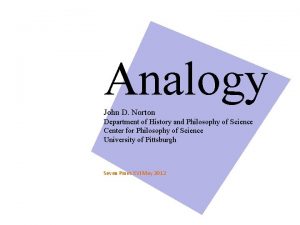
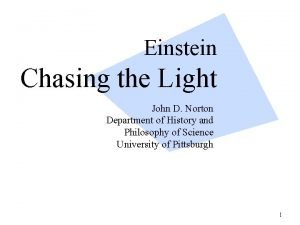
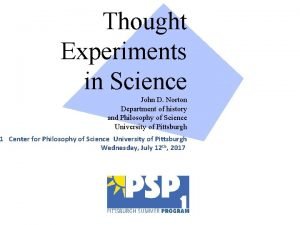

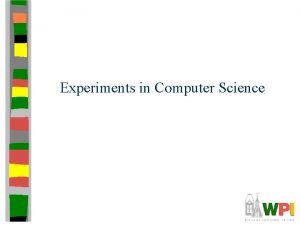
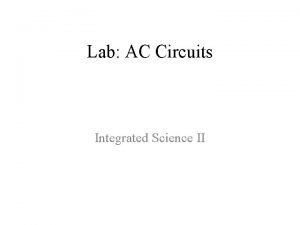









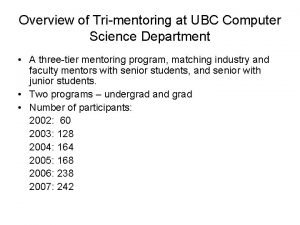



![[http://earthobservatory.nasa.gov/experiments/biome/] [http://earthobservatory.nasa.gov/experiments/biome/]](https://slidetodoc.com/wp-content/uploads/2020/11/1537165_35fb5ecc588217ed14768e866616d64b-300x169.jpg)

